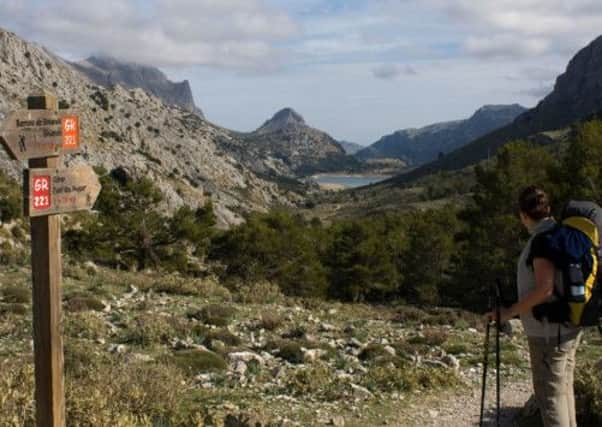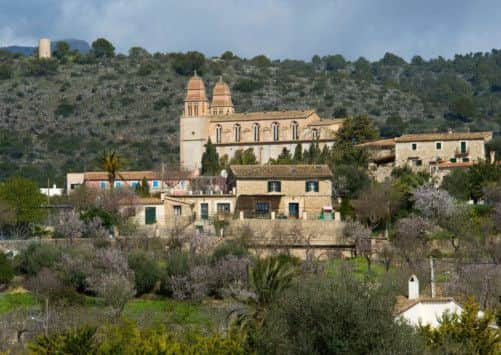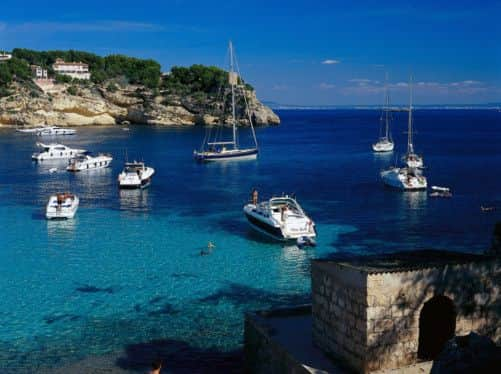Travel: lesser spotted Mallorca


There can be few places where the contrast between sometimes over-developed coastline and hinterland is as sharply delineated as it is in Mallorca. Little more than half an hour by car from our hotel near Palma we were in deep, tranquil countryside, with only bird song, sheep bells, the scuffling of startled goats and the sound of foliage disturbed by the breeze to disturb the silence. And another 30 minutes or so on foot brought us to the Finca de Galatzo, an elegant manor. Dating from 1688, it was built by a landowner and wheat grower who, it is said, treated his workers as slaves. It has a delightful small garden, in the process of reclamation, where palms, lemon scented geraniums, arum lilies, and lavender grow.
The future of the finca, now owned by the province of Calvia, seems somewhat uncertain. Martin Xamena and his British-born wife Lorraine, owners of the BonSol hotel in Illetas, where we made our base, would like to see a modest restaurant opened there, where strollers and serious hikers could refuel. It lies on the GR221 long distance footpath, which winds north to the coast, crossing the Tramuntana mountain range, which forms its dramatic backdrop.
Advertisement
Hide AdWith Calvia best known for round-the-clock seaside resorts such as Magaluf, it is hardly surprising that tourism officials there would like to tempt visitors away from the highrises and pizzerias to its less commercialised corners. To this end they have just published a folder of leaflets describing walks, some gentle, some energetic. My wife and I had decided to try them out.


Our first impression had not been encouraging. Setting out to hike from the town of Calvia to the village of Galilea we had wandered for a good half an hour before discovering we had missed the way after the first five minutes. If there was a sign, it was certainly not clear. As a result we were so late getting under way that we cut the walk short after a steady climb, shaded by pine and wild olive, to the quiet village of Son Font.
East of Palma we ran into a problem to which Mallorca seems particularly prone: a footpath blocked by a landowner. Seeking a low level walk on a morning when ominous tongues of dark rain cloud licked the mountain tops – for this was not a vintage spring by Mallorcan standards – we deserted Calvia for Santa Eugenia, an attractive town of mellow stone to the east of Palma, set on a flat plain of vineyards. A short diversionary climb brought us to a hilltop where, hidden from general view among trees and shrubbery, stood the ruin of an ancient hermitage, complete with its own little Calvary of three weathered wooden crosses. It was delightful, but our pleasure was soon spoiled. Back on the main route the path described by our guidebook didn’t appear to exist any more. Yapping dogs suggested trespassing might be unwise, so we were obliged to make a long slog by road, returning the way we had come to our parked rental car.
On the path from the Finca there were no such problems. It led us past lime kilns and charcoal burners’ thatched huts and a herd of goats eyed us with suspicion. We stopped for a picnic of the excellent Mallorcan pies, containing pork or lamb and – as with some we bought in an artisan bakery in Palma – artichokes and peas, which can be found in food shops all over the island. The going, save where the surface of the footpath was of loose stones, was comfortable.
We were back at the hotel in time for a swim in the large, saltwater pool. The BonSol is a gracious, genteel sort of establishment, many of whose clients return year after year. The owners are often to be seen chatting to guests, greeting regulars as long absent friends. It has two restaurants, the main dining room where we ate delicious suckling pig and a less formal alternative overlooking the sea. A diner at the next table in the latter one evening said he was partial to sole. They weren’t planning to put it on the menu that week but the maître d’ said provided he knew the night before, he could get it. He was as good as his word. “They’ll do anything for you here,” said the man, a Scot, who was staying there with his wife for the 12th time.


The saltwater pool, one of three at the hotel, is set in a terraced, sub-tropical garden where fig, orange and pine trees grow. We guessed that a fair proportion of those stretched out on sunloungers towards the end of afternoon rarely, if ever, wandered far from the hotel’s confines. It was easy to understand why but – as anyone who has explored the beautiful interior of Mallorca will understand – it was also tempting to tell them what they were missing.